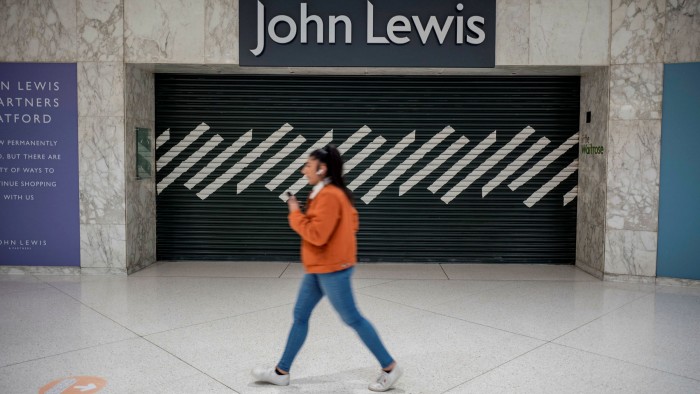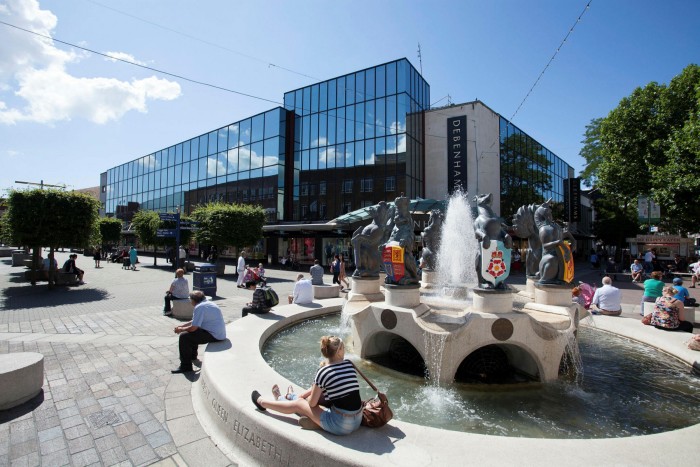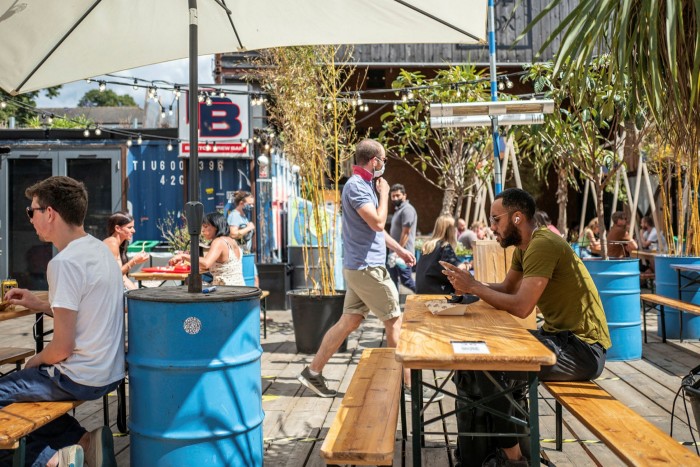Retail crisis is the mother of urban centre reinvention

Simply sign up to the Coronavirus economic impact myFT Digest -- delivered directly to your inbox.
When the UK went into lockdown in March this year, the shutters came down for the final time at John Lewis in Watford. The 96,000 square foot department store, a fixture in the commuter town for three decades, did not reopen once lockdown ended in June.
Signage on its exterior, advising customers to head to alternative stores nearby, hints at one of retail’s biggest problems: saturation.
For decades, retailers were invariably the highest bidders for commercial property in urban centres, with the result that other potential users were gradually squeezed out.
As employment, earnings and access to credit grew during the 1990s and early 2000s, retailers rolled out more and more stores. “We’ve ended up with a retail monoculture,” says Mark Robinson, a property industry executive who also chairs the UK government’s High Streets Task Force.
But once commerce moved online, retailers were left with a property hangover. About a fifth of UK retail sales were made online even before Covid-19, and more than a quarter are today. Experts estimate that the country has around 25-30 per cent more physical selling space than it needs.
Covid-19 has accelerated a cull that was already in progress; so far in 2020 over 15,000 stores have closed in the UK, according to the Centre for Retail Research. But the failure of the tenant does not remove the building. Mr Robinson says the long term solution is to “replace retail anchors with amenity uses — these could be leisure, workspace, civic amenity or residential”.
Bill Grimsey, the former boss of DIY chain Wickes and frozen food group Iceland, is another advocate of town centre reinvention.
He points to Stockton-on-Tees as an example. The council in the northeastern town bought a local shopping centre in order to demolish it and turn the area into a park. In Southsea, on England’s south coast, another former John Lewis store is being converted into a mixed-use development including a hotel, serviced offices and a cinema. Directly across the street, plans are afoot to turn a former Debenhams department store into apartments.
Proposed changes in planning law, along with several government-led schemes to provide financial support for town and city centres, are likely to lead to more of these schemes. But Paul Swinney, head of policy and research at UK think-tank Centre for Cities, cautions that conversions to residential in particular will not work everywhere.

“City centre living has only really happened in cities where there is a strong economy creating white-collar jobs,” he says. The expense and difficulty of repurposing redundant retail units meant it was often easier for councils to approve out-of-town office or retail schemes that created jobs quickly.
Some retail will remain in town centres, but what remains is likely to be more transient than it was in previous decades.
Ross Bailey, founder of Appear Here, says the days of retailers committing to specific locations for a decade or more are over. “We’ve become a bit lazy in our thinking about location, forgetting that it is only relevant because of audience,” he adds. When customers move, retailers and brands must move with them.
More youth-focused brands are eschewing the traditional trophy spots like Oxford Street, Carnaby Street or King’s Road and setting up shop in areas like Hackney, Brixton or Peckham.

While chains may still dominate in out-of-town shopping malls and retail parks, town and city centres are more likely to see a resurgence of independent retailing, which in recent years has been more resilient.
Figures from the Local Data Company show that, in each of the past five years, the net closure rate of independent town-centre businesses has been considerably less than that of chains, even during the coronavirus pandemic.
“The independent market has fared better as these businesses have been able to be more agile . . . have a smaller cost base to cover during periods of little or no trade and have been able to take advantage of government support schemes,” says Lucy Stainton, head of retail at LDC.
Although there will still be a place for convenience — stores you can “pop out” to — many shops will serve as more than just distribution points for goods. Mr Bailey talks of “shops as media” and points out that successful “omnichannel” retailers have found that online engagement is typically much higher in areas where they have physical stores.
The changing role of physical retail space will almost certainly reduce revenue per square foot — which will necessarily alter the terms on which it is rented. There is some irony in retailers who spent decades bidding up rents complaining that they are now too high. But it seems landlords increasingly agree; almost nine-tenths expect rents to fall, says real estate adviser Savills.
Average UK lease lengths have been shortening for some years, with Savills expecting 90 per cent of new leases to be for five years or less by 2022. And landlords are increasingly receptive to turnover-based agreements, where the rent payable is a function of the sales the shop achieves.
Ms Stainton says she has “no doubt” the eventual result will be town and city centres that have more concentrated yet more diverse and attractive retail and hospitality offerings. The only question is how long it will take to get there.
Comments